Serviços Personalizados
Journal
Artigo
Indicadores
-
 Citado por SciELO
Citado por SciELO -
 Acessos
Acessos
Links relacionados
-
 Similares em
SciELO
Similares em
SciELO
Compartilhar
Comunicações Geológicas
versão On-line ISSN 1647-581X
Comunicações Geológicas n.96 Amadora 2009
Geodynamic evolution of the São Fidelis -Santo António de Pádua sector, central Ribeira Fold Belt, SE Brazil
T. M. Bento dos Santos*1; P. E. Fonseca**; J. M. Munhá**; C. C. G. Tassinari*** &C. Dias Neto***
* LNEG – Laboratório Nacional de Energia e Geologia, Estrada da Portela – Zambujal – Alfragide, 2720-866 Amadora, Portugal (1Corresponding author: telmo.santos@ineti.pt);
** Centro/Departamento de Geologia, Universidade de Lisboa, Edifício C6, 3º, Campo Grande, 1749-016 Lisboa, Portugal. pefonseca@fc.ul.pt;
*** Instituto de Geociências, Universidade de São Paulo, Rua do Lago, 562 – Butantã, CEP: 05508-080, São Paulo, Brazil. ccgtassi@usp.br.
Abstract
New structural analysis and petrological results on granulites from the central segment of Ribeira Fold Belt indicate that the regional thrusts D1 (245-260° , 55-70° NW) was coeval with the high grade peak metamorphism at 565 – 575 Ma, post-dating earlier collision related nappe thrusts at 630 – 610 Ma (D0). These were mostly erased by D2 thrusting and long-term dextral transpressional shearing (50-65° , 70-85° NW), simultaneous with very slow cooling of the orogen until 480 – 520 Ma. Brittle, extensional, tectonic event D3 (290-320° , subvertical) is associated with late granite emplacement in the area, being followed by tectonic collapse that resulted in rapid exhumation/cooling of the high grade rocks at ~ 470 Ma. Results suggest that a > 35 Ma period of nearly orthogonal shortening between the San Francisco and West Congo cratons occurred until 565 Ma with development of the D1 flower thrust system. Afterwards, when rocks could not absorb further orthogonal shortening, D2 dextral transpressive regime became dominant, turning the flower structure asymmetric. Specific positioning within the flower structure and partition of deformation induced “local” antithetical sinistral kinematics within the main regional dextral regime and differential exhumation: granulites in the central axis were rapidly exhumed, whereas along the lateral branches exhumation was much slower resulting in very slow cooling that lasted for almost 100 Ma.
Keywords: Transpression, flower structure, deformation partition, antithetical kinematics, Ribeira Fold Belt.
Resumo
Análise estrutural e resultados petrológicos recentes em granulitos da zona central da Faixa Ribeira indicam que a fase de deformação D1 (cavalgamentos de alta temperatura: 245-260° , 55-70° NW) foi simultânea com o pico metamórfico, atingido aos 565 – 575 Ma, após os episódios colisionais com imbricação de nappes há 630 – 610 Ma (D0). Os marcadores cinemáticos de D0 e D1 foram abundantemente apagados pela fase de deformação D2. Esta apresentou uma componente cavalgante e, fundamentalmente, de cisalhamento direito (50-65° , 70-85° NW), associada a transpressão direita de longa duração, relacionada com uma prolongada taxa de arrefecimento do orógeno que durou até 480 – 520 Ma. O evento tectónico D3, frágil e em regime extensional (290-320° , subvertical), associado a relaxamento térmico e à instalação de granitos tardios na área, foi seguido pelo colapso orogénico, aumentando drasticamente as taxas de arrefecimento há ~ 470 Ma.
Os resultados sugerem que terá ocorrido um período de > 35 Ma de encurtamento ortogonal entre o Cratão de São Francisco e o Cratão do Congo Ocidental, até há 565 Ma, com o desenvolvimento da estrutura em flor D1. Posteriormente, quando as rochas deixaram de suportar encurtamento, o regime transpressivo direito D2 tornou-se predominante, tornando a estrutura em flor assimétrica. O posicionamento específico no interior da estrutura em flor e a existência de uma forte partição da deformação induziu cinemática antitética esquerda em alguns locais, dentro da estrutura predominantemente direita, bem como exumação diferencial: os granulitos na zona central da estrutura foram rapidamente exumados, enquanto nos ramos laterais a exumação procedeu-se de uma forma mais lenta, resultando em taxas de arrefecimento muito baixas que duraram quase 100 Ma.
Palavras-chave: Transpressão, estrutura em flor, partição da deformação, cinemática antitética, Faixa Ribeira.
1. INTRODUCTION
Geochronological studies and structural analyses of different sectors of Ribeira Fold Belt (RFB) made in the past (CORDANI, 1971; CAMPOS NETO & FIGUEIREDO, 1995; MACHADO et al., 1996; HEILBRON & MACHADO, 2003; SCHMITT et al., 2004; ALKMIN et al., 2006) allowed a better understanding of the global evolution of this orogenic belt from collision to late-exhumation times. However, main relationships between the thermotectonic evolution of this Western Gondwana belt and the imprinted structural features that usually characterize the Braziliano granulites and the regional size structure centred in the Paraíba do Sul River valley are still to explore. In this work, we will try to integrate and summarize the most recent petrological and thermochronological data (BENTO DOS SANTOS, 2008; BENTO DOS SANTOS et al., 2007; 2008b; FONSECA et al., 2008, TASSINARI et al., 2006) with the field work developed during the 2004-2009 campaigns with the purpose of obtaining a new multidisciplinary view of the thermotectonic/geodynamic evolution of the central segment of the RFB, with a main focus on the development of the tectonic framework associated with the Além Paraíba – Santo António de Pádua megashear.
2. GEOLOGICALSETTING
The studied São Fidelis – Santo António de Pádua (SFSAP) sector, is located in the central-north RFB (CORDANI, 1971), northern Rio de Janeiro State, SE Brazil (Fig. 1). The RFB extends along the SE coast of Brazil, over 1,500 km from southern Bahia State to Uruguay, through Espírito Santo, Rio de Janeiro, Minas Gerais, São Paulo and Paraná States (CORDANI et al., 1973). This elongated belt is a NE-SW trending (south and central sectors) and NNE-SSW trending (northern sector) Neoproterozoic mobile belt (CORDANI et al., 1973) formed in the Braziliano-Panafrican Orogeny, as outcome of the collision between the São Francisco and West Congo cratons (Fig. 2), from which resulted the southern part of Western-Gondwana at around 670 – 480 Ma ago (TROUW et al., 2000). Some authors (EBERT & HASUI, 1998; CAMPOS NETO, 2000) also envisage the involvement of a third cratonic block (or shield), responsible for the southern RFB structural features, that nowadays lies beneath the Paraná sedimentary basin.
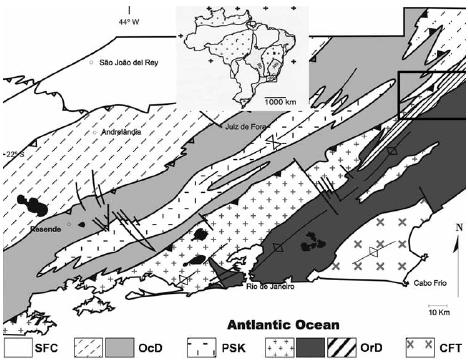
Fig. 1 – Location of the studied São Fidelis – Santo António de Pádua sector (SFSAP) in the central-north Ribeira Fold Belt, northern Rio de Janeiro State, SE Brazil (Modified from HEILBRON & MACHADO, 2003). SFC – São Francisco Craton; OcD – Occidental Domain; PSK – Paraíba do Sul Klippe; OrD – Oriental Domain; CFT – Cabo Frio Terrane. Box locates studied area.
Fig. 2 – Location of the central Ribeira Fold Belt and the Além Paraíba – Pádua Shear zone in the Gondwana Supercontinent (modified from PIPER, 2000) (a) and Ribeira Fold Belt positioning in the Western Gondwana context as the result of the amalgamation between the São Francisco (SF) and the Congo (Co) cratons (Modified from TROUW et al., 2000) (b). Further abbreviations as in TROUW et al. (2000).
One of the main features of this belt is that it constitutes a very complex orogenic zone composed of several geological units separated by deep dextral shears (DIAS NETO et al., 2006). The SFSAP sector is located immediately SE to one of this megashears, the Além Paraíba – Santo António de Pádua shear (APPS) (EGYDIO-SILVA et al., 2002), that strongly deformed the area rocks imposing a NE-SW trending dextral transpressive shear deformation associated with high grade metamorphism (Fig. 3).
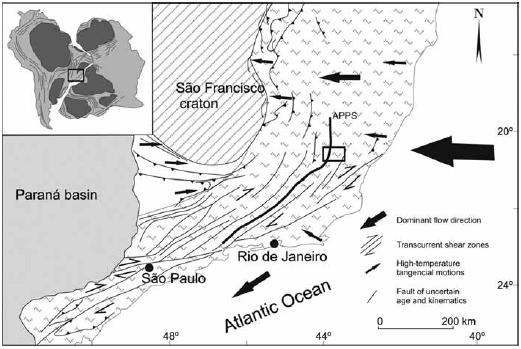
Fig. 3 – The Além Paraíba – Pádua Shear (APPS) system in the central Ribeira Fold Belt (Modified from VAUCHEZ et al., 1994). APPS main shear is bold and marked. Box locates studied area.
According to TROUW et al. (2000), RFB could be divided in four major lithologic associations: a) reworked Archaean to Paleoproterozoic basement rocks composed of metavolcanic-sedimentary sequences, granodioritic orthogneisses and intermediate granulites (HEILBRON et al. 1998); b) a deformed meta-sedimentary sequence composed of pelitic schists and high grade migmatitic paragneisses with quartzite, calc-silicate and amphibolite intercalations; c) molasic sedimentary basins and d) widespread granitoid intrusive bodies with different tectonic settings, from pre- to post-collision stages of the Braziliano orogenic system.
A common lithologic feature of the RFB is the widespread occurrence of Neoproterozoic charnockites. These occur as massive metamorphic charnockites, variable sized patches and veins of incipient charnockites and as sin-/late intrusions of enderbites, commonly considered as massif-type igneous charnockites (TASSINARI et al., 2006).
Various tectonic, interpretative kinematics and geodynamic models have been proposed for the tectonometamorphic evolution of the RFB (TASSINARI & CAMPOS NETO, 1988; HEILBRON et al., 1993; CAMPOS NETO & FIGUEIREDO, 1995; MACHADO et al., 1996; TROUW et al., 2000; CAMPOS NETO, 2000; SCHMITT, 2001; HEILBRON & MACHADO 2003) and other restricted areas (DIAS NETO et al., 2006). A dominant ensialic evolution with important crustal reworking has been favoured (CORDANI, 1971; CORDANI et al., 1973), although subordinated oceanic crust subduction (and obduction) and continental accretion have also been considered (PEDROSA SOARES & WIEDEMANN-LEONAR-DOS, 2000; PEDROSA SOARES et al., 2001).
According to CAMPOS NETO & FIGUEIREDO (1995) the RFB includes distinct microplates, which were amalgamated on Neoproterozoic and Eopaleozoic times, producing the actual patchwork scenario. Within the Serra do Mar microplate, which includes the Costeiro Complex, the Rio Doce Orogeny was active from 590 Ma to 570 Ma, involving calc-alkaline arc magmatism, followed by collision (560 – 530 Ma) of the microplate against the continent and post-collision magmatism (520 – 480 Ma), characterized by the emplacement of alkali-calcic plutons and dikes.
Within the Rio de Janeiro State (central RFB), HEILBRON et al. (1993) and MACHADO et al. (1996) proposed a tectonometamorphic evolution of the Braziliano Orogeny divided in 3 stages: a collision period (590 – 565 Ma) in which occurred the main deformation (D1 + D2) and the main metamorphic period (M1) with reworking and partial melting of older continental basement rocks and emplacement of several granitoid bodies; followed by the post-collision period at 535 – 520 Ma, corresponding to D3 and M2 retrograde metamorphism that developed in response to major dextral shear zones formation. It was then followed by a post-tectonic period of orogenic collapse with the emplacement of late granitic plutons. In a later work, HEILBRON & MACHADO (2003) divided the central part of the RFB in four tectonic domains (klippen thrusted against the São Francisco Craton) according to geochronological data. These authors regarded the RFB as including, from NW to SE, a) the Occidental Domain, a pre-1.8 Ga passive margin succession, considered as being the reworked margin of the São Francisco Craton (basement); b) the Paraíba do Sul klippe, composed of amphibolite facies orthogneisses and meta-sediments; c) the Oriental Domain, comprising the Rio Negro Magmatic arc (TUPINAMBÁ, 1999) and fore-arc and back-arc meta-sedimentary sequences; and d) the Cabo Frio Terrane, an allochthonous terrane belonging to the West Congo Craton. A younger orogenic event, the Bœzios orogeny (SCHMITT, 2001), was defined in the Cabo Frio Terrane (TROUW et al., 2000) at 525 – 520 Ma. The referred authors suggest that the second collision (Bœzios Orogeny) exhumed the roots of the APPS producing the late shearing with strong vertical dislocation.
In the northern part of the RFB, also named Araçuaí Belt, a 625 – 595 Ma calc-alkaline magmatic arc was developed in a continental active margin; this was followed by a collision stage (595 – 575 Ma) during which fragmented slices of oceanic crust (dated 800 Ma, minimum age for ocean-floor basalts) were obducted upon the sedimentary sequences. Long-term, intensive granitic magmatism characterized late-to post-collision times, from 575 to 490 Ma (PEDROSA SOARES & WIED-MANN-LEONARDOS, 2000; PEDROSA SOARES et al., 2001). These authors proposed that RFB would be the result of the development of a complete Wilson Cycle in a confined environment, namely that the São Francisco Craton was a paleo-peninsula of the larger Congo Craton and the north end of the RFB the product of a single cycle of metamorphism in gulf-deposited sediments.
The former articles, with large impact in the scientific community, led to the concept of a Braziliano cycle with several orogenic events in which the older one, in Ribeira Fold Belt, correspond to the 630 – 600 Ma “Rio Negro Orogeny” (TUPIMAMBÁ, 1999), followed by the 625 – 575 Ma “Araçuaí’ Orogeny” (PEDROSA SOARES & WIEDMANN-LEONARDOS, 2000) and the 590 – 570 Ma “Rio Doce Orogeny” (CAMPOS NETO & FIGUEIREDO, 1995), and finally by the late ~ 520 Ma “Bœzios orogeny” (SCHMITT, 2001) in the Cabo Frio terrane.
This work brings a new conceptual model for the studied area, resulting from an innovative approach of integrating the structural data with geochronologi-cal/thermochronological data in central RFB.
3. STRUCTURAL ANALYSIS
This study is concentrated in the near area SE to the Além Paraíba – Santo António de Pádua megashear, within the São Fidelis – Santo António de Pádua sector (over 2500 Km2 wide) of the Ribeira Fold Belt.
From the structural/tectonic point of view, this area underwent complex polyphase deformation shown by three main tectonometamorphic phases that globally correspond to three main thermochronological periods (BENTO DOS SANTOS et al. 2007; BENTO DOS SANTOS, 2008). The earliest deformation period (D1) corresponds to high grade thrusts (245-260° , 55-70° NW) and stretching lineation (55-65° , 5-20° ), that were mostly erased by the major and strongest deformation phase (D2) that corresponds to the Além Paraíba – Santo António de Pádua polyphasic thrust and shear system (APPS). The most impressive shear system in the region (D2) corresponds to a dextral transpressive megashear zone (50-65°, 70-85° NW) with a sub-horizontal stretching lineation (5-20° , 230-235° ). A dextral high grade conjugated system (120-140° , 80-85° SW)(D2b) related and synchronous to D2 can commonly be observed. It is a NNE-NE thrusting system with stretching lineation printed along the mylonitic foliations of 70° , 230° that is imprinted (at diverse scales including satellite views) by the structural/geomorphologic features drawn by the river in the Santo António de Pádua – São Fidelis sector (Fig. 4). Finally a brittle tectonic event (corresponding to the intrusion of the granitoids) D3, corresponds to the reactivation (opening and thermal relaxation) of the D2b shear system (290-320°, subvertical) (Fig. 5). Also ubiquitously present in the studied area as part of the late brittle regime, crosscutting all the previous structures, is a metric scale sub-horizontal discontinuity (D3b) that represents the tardy-tectonic rebound of the exhumation--caused tectonic collapse (CLIFT et al., 2004).
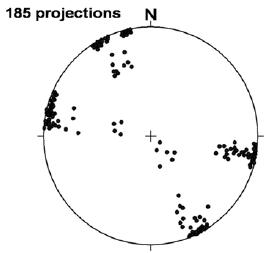
Fig. 4 – Stereographic projection of stretching lineations mapped along the mylonitic foliations of D2 APPS system showing rare high vertical ascension in the central parts of the flower structure and dominant almost horizontal shearing in the lateral branches of the flower structure. Lower hemisphere equals area plot.
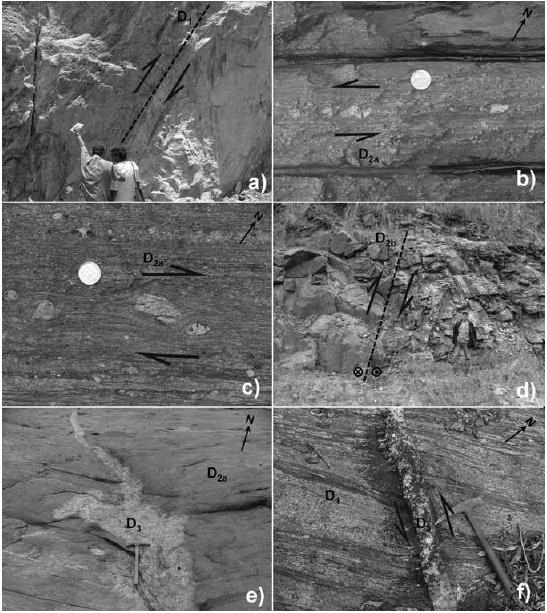
Fig. 5 – Summarized deformation phases present in the studied area: a) D1 high-temperature thrusts in metatexites; b) and c) APPS in the Três Rios area showing book-shelf (special antithetical sinistral kinematics) and dominant dextral “thrusting clasts” textures; d) conjugated D2b of the APPS with thrusting of a granulite onto a sheared migmatite near Cambuci; e) Late D3 pegmatite outcrop cutting the D2 amphibolites in Três Rios; f) Late D3 pegmatite cutting metatexites.
The stated field observations are compatible with a global structural framework of an asymmetrical flower structure tilted to the São Francisco Craton but with a larger (verging) SE branch, as the result of the collision between the two cratons (Fig. 6).
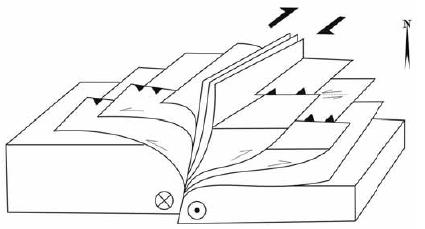
Fig. 6 - 3D schematics of the inferred asymmetric flower structure present in the studied area. The studied area is located in the central (Santo António de Pádua) to the east (São Fidelis) part of the roots of this flower structure.
An important structural feature of the studied area is that D1 + D2 deformation phases correspond to a dextral transpressional regime developing in a non-homoge-neous tectonic system with characteristics of deformation partition (TEYSSIER et al., 1995; TASSINARI et al., 2004), evidenced by the cartographic presence of secondary discrete megashear corridors (Fig. 7) occurring parallel to the main APPS, separated by considerable distances (5 to 10 km).
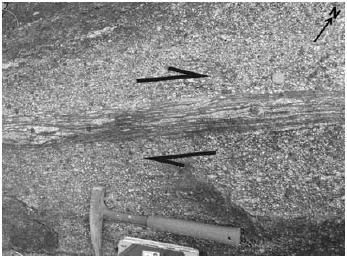
Fig. 7 – Detailed example (at outcrop scale) of deformation partition where a centimetric dextral corridor concentrates deformation.
Intense granulite facies metamorphism simultaneous with D1 collision phase produced generalized migmatization and granitization by the partial melting of paragneisses. Outcrops in the area comprise the referred migmatitic paragneisses (metatexites), interlayered with marbles, calc-silicates and amphibolites; diatexitic migmatites; massive and incipient-type charnockites associated with their granitic to granodioritic orthogneiss precursors and aplites; and blastomylonites that resulted from the relatively late deformation (D2) and retrogression of the other major rock types in areas closer to the APPS (Fig. 8 – 11). The former lithologic units are commonly intruded by late undeformed granites and pegmatitic veins associated with D3.
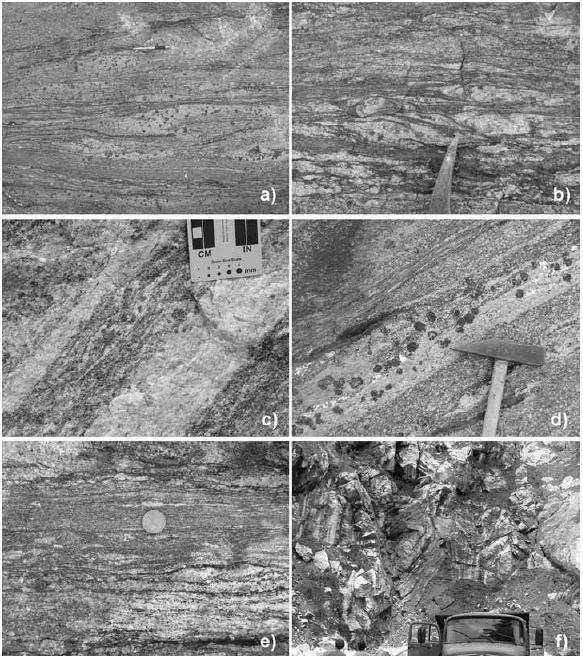
Fig. 8 – Several field examples of the studied metatexites (a-e) and marble pockets in metatexites (f).
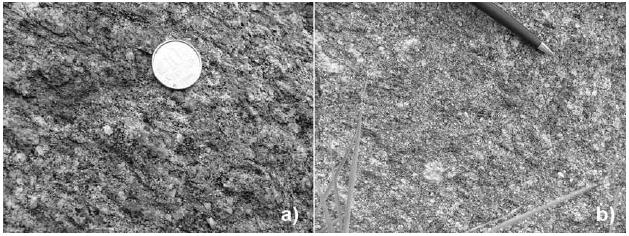
Fig. 9 – Field examples of the studied diatexites showing clear homogeneous look.
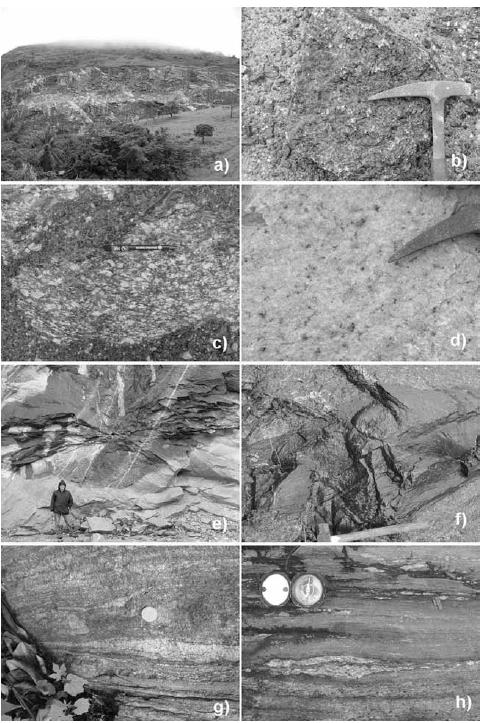
Fig. 10 – Several field examples of the studied massive charnockites (a-b); orthogneisses (c); aplites (d-e); and sheared charnockites (f-h).
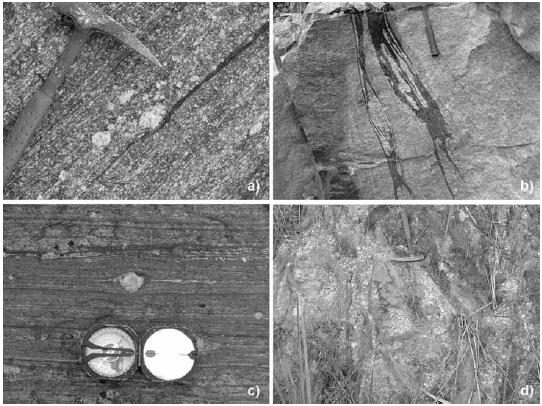
Fig. 11 – Field examples of the studied blastomylonites.
Metatexites show a clear separation of gneissic paleosome and aplitic neosome. Gneissic banding is well developed in these rocks, as well as clear evidence of late deformation and retrogression. Diatexites comprise large elongated or rounded, undeformed and homogeneous granular garnet-biotite-hornblende granitic to migmatitic batholiths, derived by the partial melting of metatexites. In the study area, charnockitic rocks range from enderbites (basic charnockites) to charnockites (s. s.), occurring in elongated NE-SW trending massifs.
The structural observations performed in the study area allow us to state that the amphibolitic facies retrogression of this granulitic sector is intimately associated with the large late dextral shearing that produced the blastomylonitic occurrences, as well as the major rock lineaments. However, this late deformation was not equally distributed, as metatexites present a penetrative deformation whereas the stiffer charnockitic and diatexitic rocks preserved themselves as very large boudins with deformed margins. Geomorphologically, these granular rocks (charnockites and diatexites) are inselbergs placed between deformation corridors that preserved them as kilometric boudins with deformed margins, a typical case of deformation partition in the study area. Field cartography of the studied area further shows that these outcrops were constrained by the main deformation structures that produced a “boudinage”-like mapping with the migmatites stretching lineations outlining the main rigid bodies, especially away from the centre of the APPS (Fig. 12).

Fig. 12 – Geological map of the studied SFSAP sector that evidences mega-shear corridors and boudin-like outcropping for charnockites and diatexites in a “matrix” of migmatites and blastomylonites. Tectonic imbrication is visible for charnockites and diatexites. Stereographic projections show progressive dip decrease of the D1 stretching lineations (X1) from Santo António de Pádua area (centre of the APPS flower structure) to São Fidelis area (lateral branch of the flower structure). £Sm is the average pole for the mylonitic foliations where stretching lineations were measured. Lower hemisphere equals area plot.
Another geomorphologic example of inferred deformation partition is the abrupt change in the direction of the main course of the Paraíba do Sul River that is tectonically controlled by the dextral D2b conjugated shears that are also discrete corridors, although with a smaller strain rate than the main APPS.
Also seldom present in the study area is a sinistral antithetical regime near the strong and imposing dextral faults that globally dominate and define the tectonic D2 transpressive regime.
Field observations and stereographic projections also suggest that the studied area underwent strong deformation partition that placed highly deformed rocks side by side to almost isotropic rocks (like the charnockite massifs). Moreover, it is suggested that it was this long--term transpressive regime, with associated deformation partition, that slowly exhumed the roots of this lower crust segment (Fig. 13).
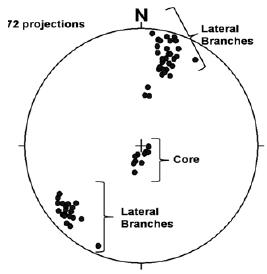
Fig. 13 – Stereographic projection with D1 high-temperature thrusts showing clear dichotomy between the central part of the flower structure (almost vertical thrusting) and the lateral branches that show almost horizontal imbrication-style shearing. Lower hemisphere equals area plot.
Summarizing, the study area is characterized by a long and strong megastructure – the APPS shear system – with a current low angle stretching lineation (10-15° ) underlined by the Paraíba do Sul River between Andrade Pinto and Cambuci (Rio de Janeiro State). This megastructure is the central axis of a complex parallel shear system dominated by discrete structures in a globally transpressional regime that deformed and retrograded the high grade granulitic rocks and exhumed the various lithologies at different rates (BENTO DOS SANTOS et al., 2007; BENTO DOS SANTOS, 2008).
The first collision pulse of the transpression is made by high velocity vertical movements (D1) at the apical zone, whereas the parallel “lateral sheets or lateral ramps” of the inferred asymmetrical flower structure have lower dip angles, which makes its ascension (exhumation) to be much slower, as commonly observed in flower structures systems (Fig. 6).
Because the collision between the two cratons (São Francisco and West Congo) is oblique and progressively more tangential, a dramatically change in the exhumation rate between the centre of the structure and the lateral sheets occurs: while the movement is mainly collision, with fast shortening by compression of the central part, exhumation of the central part is faster than in the periphery, and when the main shortening process ends and transpression becomes the main deformation process (SANDERSON & MARCHINI, 1984), the main vertical ascension changes to the lateral sheets, turning the exhumation rates from fast to slow in the central part and inversely in the lateral sheets (Fig. 14).
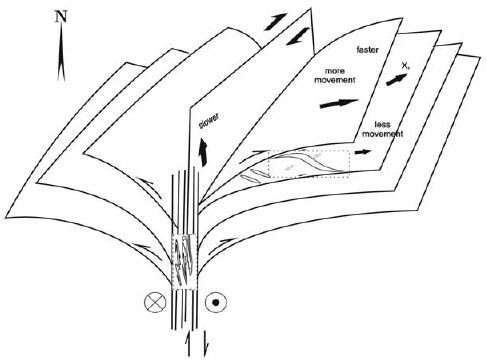
Fig. 14 – Geodynamic evolution of the APPS system and tectonic implications of exhumation for the central and peripheral parts of the flower structure during D1 and D2 deformation phases.
4. PETROGRAPHY
4.1. Metatexites
The metatexites paleosome commonly comprises a g + bi + pl + q + ksp + ru + mt ± ilm ± ap ± sill ± mu ± sp (Mineral abbreviations according to POWELL & HOLLAND, 1999) gneissic association, whereas the neosomatic fraction is a q + pl + ksp + g + bi ± sill ± ap aplite (Fig. 15).
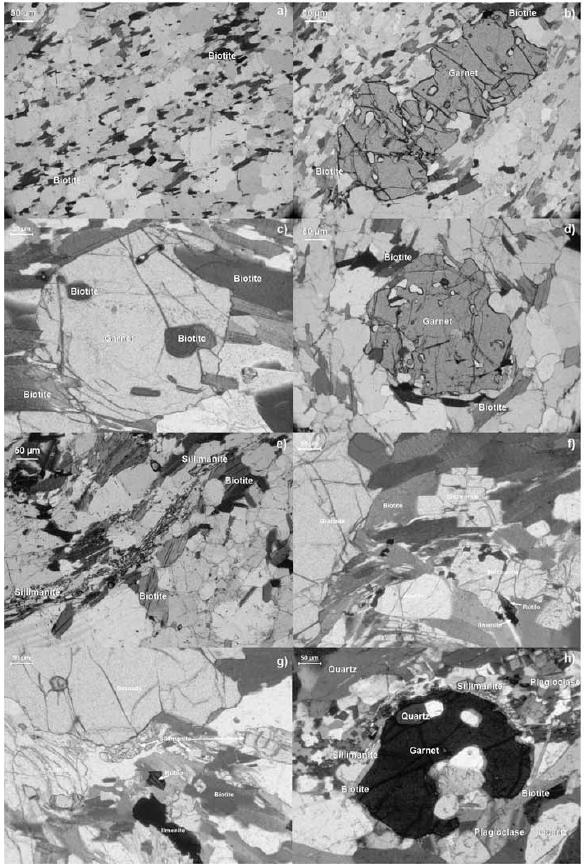
Fig. 15 – Metatexite petrography with generic mineral assemblages present in these rocks.
The anastomosing granolepidoblastic texture largely defined by the bi + q association is commonly obliterated by coarse grained, sometimes centimetric, sub-euhedral or rounded poikiloblastic garnet, plagioclase and K-feldspar granoblasts. These megablasts frequently have matrix mineral inclusions, like biotite and opaque minerals, and are usually deformed, bent, cracked and with recrystalized rims, representing the metamorphic peak paragenesis of the metatexites, possibly with small amounts of quartz and residual biotite. Quartz is also abundant in garnet microcraks and in contact areas between megablasts. Symplectitic bi + q + sill growth after garnet is a common feature of these rocks. In some cases these migmatites are intensively sheared, originating fine grained mylonitic banding with abundant (sometimes centimetric) sillimanite and/or muscovite.
4.2. Diatexites
Homogeneous, undeformed, medium grain sized pl + q + ksp + bi + g + amph ± ap assemblage is typical, having rare ilmenite, muscovite and in one case small amounts of orthopyroxene (Fig. 16). The texture is frequently dominated by biotite, imposing a granolepidoblastic texture to the rock or in some cases, granonematoblastic, when amphibole is dominant. Garnet is commonly surrounded by biotite and amphibole, whether along the rims or in small symplectites with quartz.
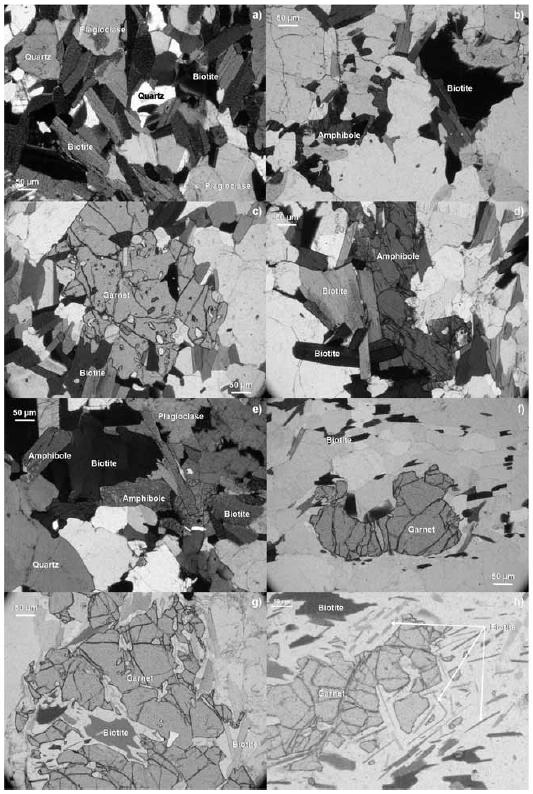
Fig. 16 – Diatexite petrography with generic mineral assemblages present in these rocks.
4.3. Charnockites
According to their paragenesis and occurrence they can broadly be divided in three types:
a) isotropic charnockites (s. s.): medium to coarse sized granoblastic texture with megablastic (sometimes centimetric) sub-euhedral pl + ksp (microcline) + g + opx is common. Q + bi + ilm + mt + ap + zrc are only present as diffuse, rarely orientated, matrix minerals. As in metatexites, megablasts commonly have a large amount of mineral inclusions, as well as, deformed and cracked rims. Bi + q symplectites are common around garnet and pyroxene rims (Fig. 17);
b) Margins of the charnockite massifs: charnockites with fine grained mylonitic or cataclastic lepidoblastic texture with bi + pl + ksp + q + opx (relict) + ap ± g ± amph mineral assemblage. Metamorphic peak minerals (pl + ksp + q + opx + g) are intensively deformed, fractured, grinded, and replaced by an amphibolite facies assemblage of bi + amph + ilm (Fig. 18);
c) Enderbites: banded, medium to coarse grained sub-euhedral pl + opx + cpx + g metamorphic peak paragenesis, replaced by the amph + pl ± bi assemblage is a common feature of these basic charnockites. The large amount of amphibole and small amount of biotite imprint a granonematoblastic texture to this rock. Contrary to charnockites (s. s.), enderbites show large quantity of clinopyroxene, probably due to its more calcic composition. In fact, it is possible to observe amphibole inclusions in pyroxene and at the same time amphibole replacing both orthopyroxene and clinopyroxene (Fig. 19).
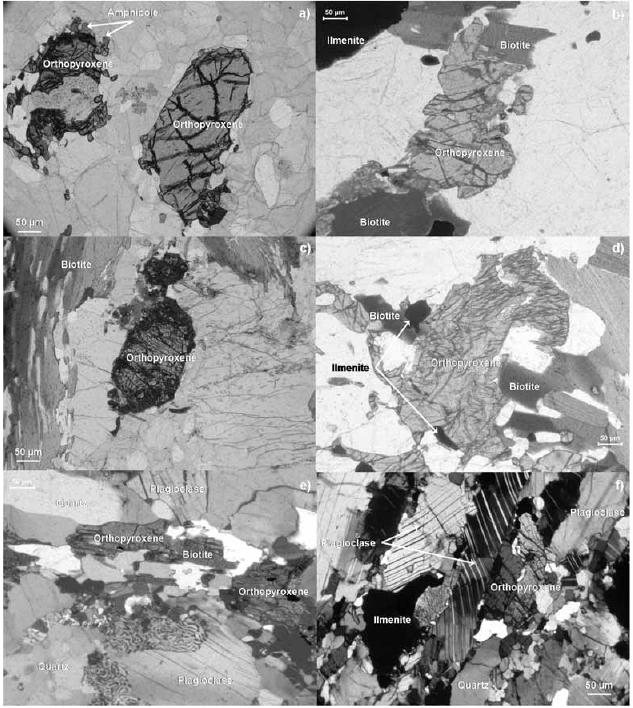
Fig. 17 – Petrography (with generic mineral assemblages) of isotropic charnockites.
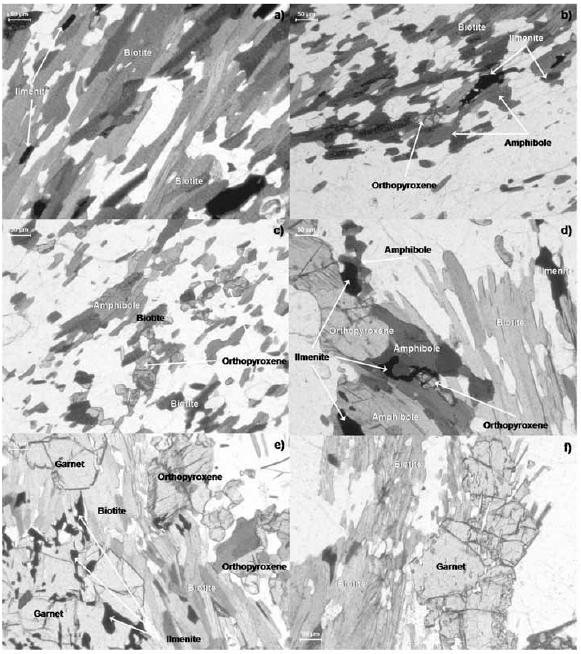
Fig. 18 – Petrography (with generic mineral assemblages) of deformed and sheared charnockites.
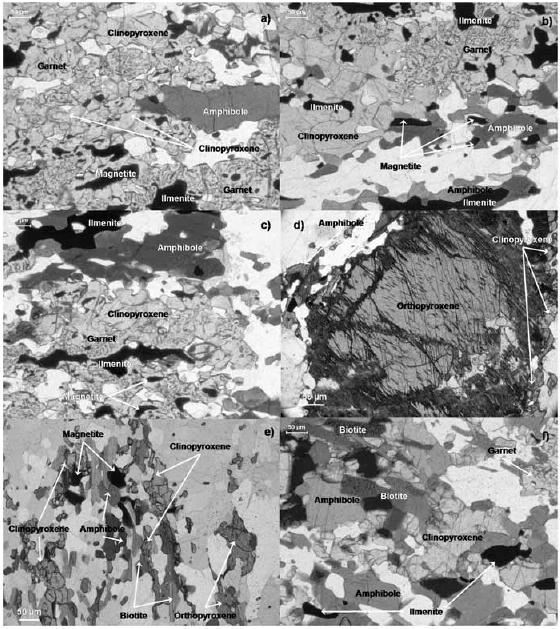
Fig. 19 – Petrography (with generic mineral assemblages) of coarse grained enderbites.
4.4. Blastomylonites
Migmatites and charnockites are profusely retrogressed and deformed in the near region of Santo António de Pádua, centre of the APPS. There, it is impossible to determine the rocks’ sources, because of the blastomylonitic transformation they have experienced. Therefore, the global denomination of blastomylonite is employed. In a petrographic point of view they are equivalent to their undeformed counterparts, with the exception of having a profuse equigranular mylonitic texture with abundant cracked, grinded and finely recrystalized mineral grains (Fig. 20). Mineralogical replacement of metamorphic peak assemblage progresses in the same way as previously stated, with the exception that in blastomylonites there are only remnants of the high grade paragenesis.
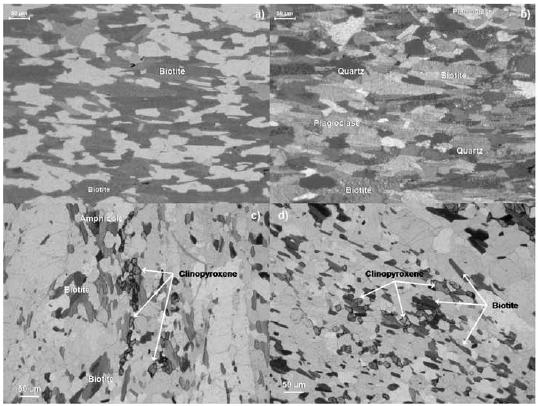
Fig. 20 – Blastomylonite petrography with generic mineral assemblages present in these rocks: blastomylonitized migmatites (a-b); blastomylonitized charnockites (c-d).
5. ANALYTICAL METHODS
Samples were prepared for the different types of analyses at the Instituto de Geociências da Universidade de São Paulo and at the Departamento de Geologia da Universidade de Lisboa.
Mineral composition data was determined on carbon coated polished thin sections using a JEOL JXA 733 wavelength dispersive Electron Microprobe, at the Centro de Geologia da Faculdade de Ciências da Universidade de Lisboa (CeGUL). Minerals were analysed with an acceleration voltage of 15 kV and a current of 10 nA, using a beam of 5 mm. Both natural and synthetic silicates and oxides were used as standards.
6. MINERAL CHEMISTRY SYNTHESIS
Extensive mineral chemistry descriptions of these rocks are accessible elsewhere (BENTO DOS SANTOS, 2008; BENTO DOS SANTOS et al., 2006; 2008a; MUNHÁ et al., 2008). A brief portrayal of the São Fidelis – Santo António de Pádua sector rocks, with main focus on blastomylonites, is presented in this chapter. Because blastomylonites are the result of late retrogression of the SFSAP sector granulites and are composed of different parageneses according to their protoliths, they commonly show a great range of compositional values in the mineral chemistry results.
6.1. Feldspars
Although anorthite contents in plagioclase (Xan) of all rock types rarely have a pronounced zoning from core to rim (maximum zoning is 0.1 for Xan, with cores having a general slightly lower anorthite content), different samples of the same rock type from different places show high scope of values, ranging from Xan = 0.29 to 0.51 for charnockites (s. s.), from Xan = 0.30 to 0.47 for enderbites, Xan = 0.27 to 0.39 for metatexites, Xan = 0.35 to 0.43 for diatexites and Xan = 0.35 to 0.50 for the interlayered amphibolites in metatexites. Blastomylonites show the greatest range in anorthite content because of the protholiths composition, ranging from Xan = 0.17 to 0.55.
K-feldspars are almost pure orthoclases, having a maximum Xab of 0.13.
6.2. Garnet
Almandine-rich phases are present in all rock types, with Xalm always higher than 0.54, and always with Mg-richer cores compared to the rims. Although, all rock types show the same zoning pattern from core (Mg-rich) to rim (Fe-rich), they all have different range of values, namely Xalm = 0.66 to 0.75 and Xpy = 0.09 to 0.21 for charnockites (s. s.), Xalm = 0.62 to 0.70 and Xpy = 0.11 to 0.15 for enderbites, Xalm = 0.58 to 0.75 and Xpy= 0.17 to 0.37 for metatexites, Xalm = 0.54 to 0.67 and Xpy = 0.07 to 0.09 for diatexites and Xalm = 0.59 to 0.77 and Xpy = 0.11 to 0.19 for blastomylonites, making the metatexites the richest in pyrope content and poorer in grossular content (maximum Xgr of 0.05) whereas diatexites have the richest grossular content (Xgr = 0.21 to 0.27). When compared with charnockites (s. s.), enderbites are naturally richer in calcium having Xgr ranging from 0.15 to 0.22, while their acidic counterparts range from 0.02 to 0.18. Spessartite content is always low, reaching a top content of 0.13 in charnockites and diatexites, while enderbites and metatexites are always below 0.05.
6.3. Pyroxenes
In charnockites, orthopyroxenes have enstatite contents (Xen) that range from 0.39 to 0.48 with a maximum 3% wollastonite content (Xwo) and Al2O3 contents ranging from 0.76 to 3.40 Wt %. They are slightly zoned with Mg-richer cores. Enderbites have similar core to rim zoning pattern and enstatite content ranging from 0.41 to 0.44 and top 2 % wollastonite content, whereas the Al2O3 content is lower, spanning from 0.59 to 0.98 Wt %. The only blastomylonitic sample with orthopyroxene has identical enstatite and Al2O3 contents as enderbites. Amphibolites included in the metatexites have higher enstatite values ranging from 0.51 to 0.52 and low Al2O3 content, ranging from 0.76 to 0.95 Wt %. Clinopyroxenes are commonly unzoned from core to rim, having a wollastonite content of 0.42 to 0.48 for all samples and enstatite contents of 0.30 to 0.35 for enderbites and blastomylonites, and 0.37 to 0.41 for amphibolites.
6.4. Biotite
Enderbites and diatexites have low-Mg biotites ranging from XMg = 0.42 to 0.43 and XMg = 0.36 to 0.38, respectively, while charnockites and blastomylonites have low to high-Mg biotites ranging from XMg = 0.39 to 0.55. TiO2 contents are relatively high for enderbites (TiO2 = = 5.7 – 5.8 Wt %) and charnockites (TiO2 = 3.8 – 6.3 Wt %), as expected for higher grade rocks, but also for blastomylonites (TiO2 = 4.9 – 5.8 Wt %). Diatexites have smaller TiO2 values ranging from 3.7 to 4.5 Wt %. Metatexites and amphibolites have Fe-poor biotites; XMg values span from 0.52 to 0.76 and 0.55 to 0.65, respectively. Their TiO2 contents are also similar (3.7 – 4.5 Wt %).
6.5. Amphiboles
Amphiboles are typically hornblendes with XMg values spanning from 0.35 to 0.54 in charnockites, enderbites and diatexites, with enderbites having progressively Mg-richer amphiboles. However, the amphibole TiO2 contents of diatexites is lower (TiO2 = 1.1 – 1.5 Wt %) than granulites (TiO2 = 1.8 – 2.4 Wt %). Amphibolites have the richest TiO2 and Mg contents in amphibole, ranging from TiO2 = 1.0 – 3.0 Wt % and XMg = 0.54 – 0.73.
7. GEOTHERMOBAROMETRY
A geothermobarometric study in the blastomylonitic occurrences was performed in order to constrain the maximum metamorphic conditions for the beginning of the APPS. Therefore, as described in the previous chapter, core and rim major element analysis of each mineral was attained.
Temperature estimates for the blastomylonitic occurrences were determined using the g-bi Fe-Mg exchange thermometer of FERRY & SPEAR (1978) corrected by HODGES & SPEAR (1982), the g-cpx Fe-Mg exchange thermometer of ELLIS & GREEN (1979), the g-amph Fe-Mg exchange thermometer of GRAHAM & POWELL (1984), the amph-pl Na-Ca exchange thermometer of HOLLAND & BLUNDY (1994), the 2 pyroxenes thermometer and the ol – cpx thermometer of ANDERSEN & LINDSLEY (1988). Pressures were determined using the GDISP barometer of ECKERT & NEWTON (1991), the GASP barometer of NEWTON & HASELTON (1981), the GRIPS and GRAIL barometers of GHENT & STOUT (1984) and the g-amph barometer of KOHN & SPEAR (1990).
Blastomylonites show retrogressed maximum temperatures and pressures ranging from 785 to 615 °C and 8.2 to 6.4 kbar. These temperature estimates are clearly within range of other existing results for the central RFB, such as BASCOU et al. (2002), KUHN et al. (2004), and SCHMITT et al. (2004). There are few works with pressure estimates for the central RFB, but these new results are higher than previously stated by other authors (REGO, 1989; KUHN et al., 2004; NOGUEIRA et al., 2004).
These temperature and pressure estimates must be considered as minimum conditions for formation of these blastomylonites as they present highly retrogressed T and P, and obviously much lower conditions than the granulitic protoliths from which they derived. Therefore, it is shown that the APPS associated deformation occurred at high-grade temperatures, which is compatible with field and geochronological data now presented. Core to rim compositional zoning for blastomylonites show DT = –150 to –250° C and DP = –1.5 to –2.5 kbar (T ~ 500 °C and P ~ 5 kbar) after maximum metamorphic conditions, that are globally considered as resulting from the continuous chemical reequilibration caused by extensive long-term shearing.
8. THERMOCHRONOLOGICAL DATA FOR THE CENTRAL RIBEIRA FOLD BELT
Because thermochronological studies use the integration of several geochronological systems with the respective closure temperature of that isotopic system, they are extremely important in depicting how different rock types were cooled, and ultimately how the exhumation process occurred, namely tectonic/geodynamic evolution from rock-forming temperatures to late-exhumation times.
Several studies performed in the south, central and north zones of the Ribeira Fold Belt (DIAS NETO, 2001; BENTO DOS SANTOS, 2008; MUNHÁ et al., 2005, respectively) have shown that after metamorphic peak conditions were reached at ~ 590 – 565 Ma (TASSINARI et al., 2006), a long-term slow cooling regime was maintained until 520 – 470 Ma (Fig. 21) when rocks began to cool rapidly by thrusting onto cooler basement or associated with post-orogenic fault tectonics, probably related with the initial stages of Paraná basin-type sedimentary infilling (BENTO DOS SANTOS et al., 2007; 2008b).
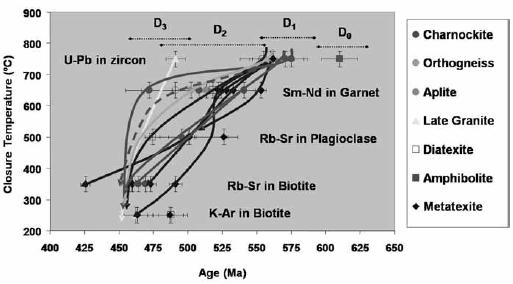
Fig. 21 – Thermochronological evolution of the studied rocks (BENTO DOS SANTOS et al., 2007a; BENTO DOS SANTOS, 2008). It is possible to observe 2 different cooling paths between metatexites and blastomylonites (squares), that reach T < 650 ºC before 520 Ma and charnockites and associated aplites and orthogneisses (circles) that reach T < 650 ºC at 520 – 470 Ma.
9. DISCUSSION
Previous works in other sectors of the Ribeira Fold Belt (MACHADO et al., 1996; SCHMITT, 2001; HEILBRON & MACHADO, 2003) suggest a prior event to D1 that correspond to the earlier imbrication nappes thrust system. Along the studied area there are no structural evidence of this previous to D1 event (here called D0) but it was clearly registered by geochronological results around 630 – 610 Ma (MACHADO et al., 1996; TASSINARI et al., 2006; BENTO DOS SANTOS et al., 2007). The referred geochronological data points out the beginning of the earlier collision stages, between the Congo and S. Francisco cratons.
The structural field studies combined with the previous thermochronological data suggest that D1 deformation phase is responsible for the early exhumation of the majority of migmatites and blastomylonites, as well as some charnockites whereas the majority of charnockites were maintained in high depths and are slowly exhumed along the lateral ramps of the branches of the collision asymmetrical flower structure. The tectonic imbrication, related with deformation partition, results in a non-homogeneous exhumation: whereas in the central axis of APPS the exhumation and ascension of the blastomylonites is swift with a strong retrogression of the lithologies, along the lateral branches the processes is much slower because of the small dip angle (5 to 10°) of the thrusts associated with the oblique stretching along these planes (30-45° of obliquity). That geometrical characteristic produces only a high retrogression on the charnockite borders whereas the “boudin”-like batholith cores remained virtually undeformed and with a preserved granulitic paragenesis. Another characteristic feature of this tectonic exhumation style is the presence of the dextral lateral shears along very discrete shear thrusts with a notorious deformation partition – that includes very deformed corridors separating blocks with almost no within deformation, as can be seen in Pedreira do Itereré where side-by-side rocks have a garnet – whole rock Sm-Nd ages with a 40 Ma age difference (BENTO DOS SANTOS et al., 2007; BENTO DOS SANTOS et al., 2008b), showing very disparate exhumation styles and rates (see Fig. 21).
Within this tectonic model, it is evident that the global evolution of the APPS system (during D1 and D2 event) from early-collision to late-exhumation times influenced the rates of exhumation in the different zones of the APPS system, as well as the lithologic associations formed during this orogeny. Therefore, it is not strange to find the main blastomylonitic occurrences in the central part of the APPS and the isotropic (or less deformed) charnockites (inferred as the last to drop from the high temperature conditions; BENTO DOS SANTOS et al., 2007) in the lateral part of the flower structure (Fig. 22).
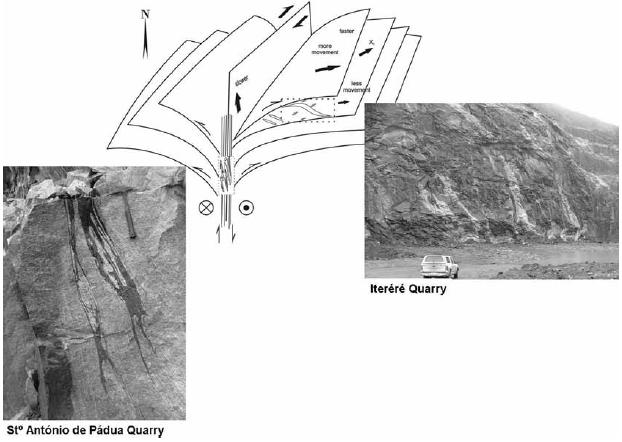
Fig. 22 – Tectonic implications on the exhumation styles of different parts of the APPS and consequent deformation/preservation of the different rocks with blastomylonite occurrence in the central part of the shear system and charnockite occurrence in the lateral branches of the flower structure.
A multiscale repeated geometry from microscale to megascale/mapping low scale dimension was observed in the studied area. An example of this peculiar geometric pattern can be observed in the repeated changes of the structural features near the rigid bodies (i.e. sigmoid biotite shape near garnets on the petrographic scale, or metatexites non-asymmetrical kinematics body with dextral shear criteria attitudes in the vicinities of charnockite “boudin”-like bodies on the regional scale).
The new structural and thermobarometric data obtained suggests that the APPS activity began at an early stage in the global tectonic evolution of Ribeira Fold Belt. Because blastomylonites (the deformed and highly retrograded granulite counterparts) show estimated mineral temperatures of almost 800° C (HOLLAND & BLUNDY, 1994), it must be assumed that these rocks were retrogressed by D2 deformation phase (APPS megashear corridors) when this crustal segment still presented very high temperatures. PORCHER et al. (1995) and BASCOU et al. (2002) also obtained very high temperatures for these blastomylonites in the near areas of Santo António de Pádua. These results are compatible with previous works developed by MACHADO et al. (1996) that suggest that APPS megashear may have begun around 600 to 550 Ma ago and BENTO DOS SANTOS et al. (2007) that constrained that initial activity at around 575 to 550 Ma.
The APPS megastructure was responsible in an early stage for the exhumation of deep rocks by a system of earlier thrusts, corresponding to a mainly collision stage that probably generated a symmetrical flower structure from which there are no evidence nowadays. These earlier deformation stages and thrust system evidence were nearly totally obliterated by the dextral main shear system where deformation partition was concentrated at discrete almost vertical surfaces. Inside the almost preserved blocks, between those discrete surfaces, it is possible to observe some antithetical sinistral kinematics in a globally dextral regime. This phenomenon occurs where the deformation partition is so intense that the rheological behaviour of a material in the vicinities of a strong dextral shear corridor is forced to have the opposite kinematics (CARRERAS, 2001) (Fig. 23). This is also suggested for the escape tectonics proposed by VAUCHEZ et al. (1992) and EGYDIO-SILVA et al. (2002) for the south and south-central RFB that probably caused the antithetic shears observed by DIAS NETO et al. (2006) in the São Sebastião – Ilha Bela region.
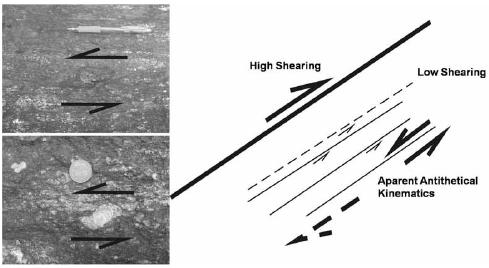
Fig. 23 – Special antithetical sinistral kinematics in a globally dextral regime caused by differential deformation rates.
The previously referred thermochronological data (DIAS NETO, 2001; BENTO DOS SANTOS et al., 2007) and the structural observations for the D2 deformation phase supports the existence of very long-term transpressive dextral regime for the APPS activity that may have lasted from metamorphic peak ages (about 575 Ma) to late exhumation of some charnockites (about 490 Ma) when D3 thermal collapse granite emplacement and a global thermal relaxation with layer-type opening of D3b discontinuities occurred.
The structural framework present in the SE Brazilian Ribeira Fold Belt underlines an oblique collision between two Paleoproterozoic cratons (being the present geographic coordinates of São Francisco at NW and West Congo at SE) and their suture corresponding to the main transpressive shear corridor in the area – APPS. This collision scar is also marked by the Dom Silvério Group 800 Ma ophiolitic remnants (PEDROSA SOARES et al., 2001) that represent a post-1 Ga (TROMPETTE, 2002) oceanization period to the north. Although, the presence of these oceanic slivers would be more probable to the SW (our study area), because of the larger space between the two cratons prior to the collision, these ophiolitic slices do not outcrop, probably because of the much stronger deformation imposed by the paleotopographic coast lines that induced a closer proximity and the respective larger strain rate.
10. CONCLUSIONS
Although in the study area there is no structural evidence for the D0 thrust nappe system, geochronologically it is inferred by the oldest 630 to 610 Ma ages previously obtained, considered as belonging to the initial stages of continental collision. A > 35 Ma period of orthogonal shortening between the two cratons occurred until ~ 575 – 565 Ma when metamorphic peak conditions were reached, simultaneously with the development of the D1 flower thrust system. When orthogonal shortening turned rheologically problematic, because rocks could not absorb further shortening, D2 dextral transpressive regime became the main deformation phase soon after the granulitic metamorphic peak at T ~ 800° C. This dextral cinematic change associated with the original São Francisco and West Congo cratons shapes produced an asymmetric flower structure with a more developed SE branch. The SE branch shows triclinic fabric features (DIAS NETO et al., 2006) with a strong oblique stretching lineation that was responsible for a very slow exhumation in the lateral branches of this flower structure that may have lasted for 80 to 100 Ma. When the long-term transpressive exhumation associated with gravitational/erosional collapse of the orogen (progressive thinning of the lithosphere) ceased, D3 relaxation opening with granitoid/pegmatitic emplacement occurred.
ACKNOWLEDGEMENTS
FAPESP, POCA-PETROLOG (CEGUL, UI: 263; POCTI/FEDER) and GEODYN (POCTI – ISFL – 5 – 32) and a PhD scholarship from FCT (SFRH/BD/17014/2004) co-financed by FEDER provided support for field and analytical work. Teresa Palácios and Octávio Chaveiro are gratefully acknowledged for long-term logistic support. The authors are very grateful to Ricardo Caranova by the elaboration and graphic treatment of some figures. The authors are also grateful for the comments and suggestions of Prof. Fernando Noronha and an anonymous reviewer that greatly added to the improvement of this work.
REFERENCES
ALKMIN, F., MARSHAK, S., PEDROSA-SOARES, A., PERES, G., CRUZ, S., WHITTINGTON, A. (2006) – Kinematic evolution of the Araçuaí-West Congo orogen in Brazil and Africa: Nutcracker tectonics during the Neoproterozoic assembly of Gondwana. Precambrian Research, 149, 43-64. [ Links ]
ANDERSEN, D., LINDSLEY, D. H. (1988) – Internally consistent solution models for Fe-Mg-Mn-Ti oxides: Fe-Ti oxides. American Mineralogist, 73, 714-726.
BASCOU, J., RAPOSO, M. I. B., VAUCHEZ, A., EGYDIO-SILVA, M. (2002) – Titanohematite lattice preferred orientation and magnetic anisotropy in high-temperature mylonites. Earth and Planetary Science Letters, 198, 77-92.
BENTO DOS SANTOS, T. (2008) – Petrologia e termocronologia de granulitos no sector central da Faixa Ribeira (Região de São Fidelis, Rio de Janeiro, Brasil). Unpublished PhD thesis, University of Lisbon, Lisbon, 388.
BENTO DOS SANTOS, T., MUNHÁ, J., TASSINARI, C., DIAS NETO, C., FONSECA, P. (2006) – Petrologia, Geoquímica e Geocronologia de Granulitos no sector São Fidelis – Santo António de Pádua, RJ, SE Brasil. VII Congresso Nacional de Geologia, 1, 241-244.
BENTO DOS SANTOS, T., MUNHÁ, J., TASSINARI, C., FONSECA, P., DIAS NETO, C. (2007) – Thermochronological evidence for long-term elevated geothermal gradients in Ribeira Belt, SE Brazil. Geochimica et Cosmochimica Acta, 71, 15, 1, A79.
BENTO DOS SANTOS, T., MUNHÁ, J., TASSINARI, C., FONSECA, P., DIAS NETO, C. (2008a) – Metamorphic evolution of Central Ribeira Belt (SE Brazil) based on pseudosections and P-T-t paths. Geophysical Research Abstracts, 10, EGU2008-A-00262.
BENTO DOS SANTOS, T., FONSECA, P., MUNHÁ, J., TASSINARI, C., DIAS NETO, C. (2008b) – Structural and thermochronological constrains on the tectonic evolution of Ribeira Belt, SE Brazil. Geophysical Research Abstracts, 10, EGU2008-A-00261.
CAMPOS NETO, M. C. (2000) – Orogenic systems from Southwestern-Gondwana: an approch to Brasiliano – Pan-Africano Cycle and collage in Southeastern Brazil. In: Cordani, U. G., Milani, E. J., Thomaz-Filho, A., Campos, D. A. (Eds.) Tectonic Evolution of South América. Rio de Janeiro, 335-365.
CAMPOS NETO, M. C., FIGUEIREDO, M. C. H. (1995) – The Rio Doce orogeny, Southeastern Brazil. Journal of South American Earth Sciences, 8, 2, 143-162.
CARRERAS, J. (2001) – Zooming on Nothern Cap de Creus shear zones. Journal of Structural Geology, 23, 1457-1486.
CLIFT, P., DEWEY, J., DRAUT, A., CHEW, D., MANGE, M., RYAN, P. (2004) – Rapid tectonic exhumation, detachment faulting and orogenic collapse in the Caledonides of Western Ireland. Tectonophysics, 384, 1-4, 91-113.
CORDANI, U. G. (1971) – Síntese da geocronologia Pré-Cambriana da região costeira atlântica meridional da América do Sul. Extended Abstract of the 25th Congresso Brasileiro de Geologia, 179-180.
CORDANI, U. G., DELHAL J., LEDENT, D. (1973) – Orogenéses superposées dans te Précambrien du Brésil sud-oriental (Etats de Rio de Janeiro et de Minas Gerais). Revista Brasileira de Geociências, 3, 1-22.
DIAS NETO, C. M. (2001) – Evolução tectono-termal do complexo costeiro faixa de dobramentos Ribeira em São Paulo. Unpublished PhD Thesis, University of São Paulo, São Paulo, 160.
DIAS NETO, C., FONSECA, P., MUNHÁ, J., EGYDIO-SILVA, M., RIBEIRO, A. (2006) – The flower structure in the Costeiro Complex (Ribeira Belt), São Sebastião (São Paulo, Brazil). Cadernos do Laboratorio Xeoloxico de Laxe, 31, 105-126.
EBERT, H. D., HASUI, Y. (1998) – Transpressional tectonics and strain partitioning during oblique collision between three plates in the Precambrian of south-east Brazil. In: Holdsworth, R. E., Strachan, R. A., Dewey, J. F. (Eds.) Continental Transpressional and Transtensional Tectonics, 135, 231-252.
ECKERT JR., J. O., NEWTON, R. C. (1991) – The 6H of reaction and recalibration of garnet-pyroxene-plagioclase-quartz geobarometers in the CMAS system by solution calorimetry. American Mineralogist, 76, 148-160.
EGYDIO-SILVA, M., VAUCHEZ, A., BASCOU, J., HIPPERTT, J. (2002) – High-temperature deformation in the Neoproterozoic transpressional Ribeira Belt, southeast Brazil. Tectonophysics, 352, 203-224.
ELLIS, D. J., GREEN, D. H. (1979) – An experimental study of the effect of Ca upon Garnet-Clinopyroxene Fe-Mg exchange equilibria. Contributions to Mineralogy and Petrology, 71, 13-22.
FERRY, J. M., SPEAR, F. S. (1978) – Experimental calibration of the partioning of Fe and Mg between biotite and garnet. Contributions to Mineralogy and Petrology, 66, 113-117.
FONSECA, P., BENTO DOS SANTOS, T., MUNHÁ, J., TASSINARI, C., DIAS NETO, C. (2008) – Thermochronological and structural analysis of the geodynamic evolution of Ribeira Belt, SE Brazil. Geochimica et Cosmochimica Acta, 72, 12, 1, A276.
GHENT, E. D., STOUT, M. Z. (1984) – TiO2 activity in metamorphosed pelitic and basic rocks: principles and applications to metamorphism in southeastern Canadian Cordillera. Contributions to Mineralogy and Petrology, 86, 248-255.
GRAHAM, C. M., POWELL, R. (1984) – A garnet-hornblende geothermometer: Calibration, testing, and application to the Pelona Schist, southern California: Journal of Metamorphic Geology, 2, 13-31.
HEILBRON M., MACHADO, N. (2003) – Timing of Terrane Accretion in the Neoproterozoic-Eopaleozoic Ribeira Orogen SE Brazil. Precambrian Research, 125, 87-112.
HEILBRON, M., TUPIMAMBÁ, M., ALMEIDA, J. C. H., VALERIANO, C. M., VALADARES, C. S., DUARTE, B. P. (1998) – New constraints on the tectonic organization and structural styles related to the Brasiliano collage of the central segment of RFB, SE Brazil. Extended Abstract of the 14th International Conference on Basement Tectonics, 15-17.
HEILBRON, M., VALERIANO, C. M., TUPIMAMBÁ, M., ALMEIDA, J. C. H., VALADARES, C., SILVA, L. G. E., NVA, D. B., DIOS, F. B. (1993) – Compartimentação tectónica e evolução geológica do segmento central da Faixa Ribeira, a Sul do Cráton do São Francisco. Extended Abstract of the II Simpósio do CSF, 263-265.
HODGES, K. V., SPEAR, F. S. (1982) – Geothermometry, geobarometry and the Al2SiO5 triple point at Mt. Moosilauke, New Hampshire. American Mineralogist, 67, 1118-1134.
HOLLAND, T. J. B., BLUNDY, J. D. (1994) – Non-ideal interactions in calcic amphiboles and their bearing on amphibole-plagioclase thermometry. Contributions to Mineralogy and Petrology, 116, 433-447.
KOHN, M. J., SPEAR, F. S. (1990) – Two new geobarometers for garnet amphibolites, with applications to southeasthern Vermont. American Mineralogist, 75, 89-96.
KUHN, A., STUWE, K., TROUW, R. A. J. (2004) – Metamorphic evolution of the RFB: Evidence from outcrops in the Rio de Janeiro Area, Brazil. Journal of Petrology, 45, 11, 2303-2323.
MACHADO, N., VALLADARES, C., HEILBRON, M., VALERIANO, C. (1996) – U-Pb geochronology of the central RFB Brazil and implications for the evolution of the Brazilian Orogeny. Precambrian Research, 79, 347-361.
MUNHÁ, J., BENTO DOS SANTOS, T., TASSINARI, C., FONSECA, P. (2008) – Pseudosection and thermobarometry constraints on the P-T-t evolution of Ribeira Belt, SE Brazil. Geochimica et Cosmochimica Acta, 72, 12, 1, A664.
MUNHÁ, J., CORDANI, U., TASSINARI, C., PALÁCIOS, T. (2005) – Petrologia e Termocronologia de gnaisses migmatíticos da Faixa de Dobramentos Araçuaí Espírito Santo, Brasil. Revista Brasileira de Geociências, 35, 1, 123-134.
NEWTON, R. C., HASELTON, H. T. (1981) – Thermodynamics of the garnet-plagioclase-Al2SiO5-quartz geobarometer. In: Newton,
R. C., Navrotsky, A, Wood, B. J. (Eds) Advances in Physical Geochemistry. New York, 1, 131-147.
NOGUEIRA, J., CHOUDHURI, A., BELLO, R. (2004) – Inclusões fluidas em granulitos e caminhos P-T-t retrometamórficos para o complexo Juiz de Fora. Revista Brasileira de Geociências, 34, 4, 509-520.
PEDROSA SOARES, A. C., NOCE, C. M., WIEDMANN-LEONARDOS, C. M., PINTO, C. P. (2001) – The Araçuaí-West Congo Orogen in Brazil: an overview of a confined orogen formed during Gondwanaland assembly. Precambrian Research, 110, 307-323.
PEDROSA-SOARES, A. C., WIEDEMANN-LEONARDOS, C. M. (2000) – Evolution of the Araçuai Belt and its connection to the RFB, Eastern Brazil. In: Cordani, U. G., Milani, E. J., Thomaz-Filho, A., Campos, D. A(Eds.) Tectonic Evolution of South America. Rio de Janeiro, 265-285.
PIPER, J. (2000) – The Neoproterozoic Supercontinent: Rodinia or Paleopangea? Earth and Planetary Science Letters, 176, 131-146.
PORCHER, C., FERNANDES, L., EGYDIO-SILVA, M., VAUCHEZ, A. (1995) – Dados preliminares do metamorfismo M1 da Faixa Ribeira: Região de Três Rios e Santo Antônio de Pádua (RJ). Abstract of the V Simpósio de Estudos Tectônicos, 71-73.
POWELL, R., HOLLAND, T. (1999) – Relating formulations of the thermodynamics of mineral solid solutions: Activity modelling pyroxenes, amphiboles and micas. American Mineralogist, 84, 1-14.
REGO, I. T. S. F. (1989) – Petrologia e geoquímica da unidade charnockítica Bela Joana, Região de São Fidélis – RJ. Unpublished PhD Thesis, University of São Paulo, São Paulo, 333.
SANDERSON, D.J., MARCHINI, W.R.D. (1984) – Transpression. Journal of Structural Geology, 6, 449-459.
SCHMITT, R. S. (2001) – A Orogenia Búzios – um evento tectonometamórfico Cambro-Ordoviciano caracterizado no domínio tectónico Cabo Frio, Faixa Ribeira, sudeste do Brasil, Rio de Janeiro. Unpublished PhD Thesis, Federal University of Rio de Janeiro, Rio de Janeiro, 273.
SCHMITT, R. S., TROUW, R. A. J., SCHMUS, W. R., PIMENTEL, M. M. (2004) – Late amalgamation in the central part of West Gondwana: new geochronological data and the characterization of a Cambrian collision orogeny in the RFB (SE Brazil). Precambrian Research, 133, 29-61.
TASSINARI, C., CAMPOS NETO, M. C. (1988) – Precambrian continental crust evolution of southeastern S‹o Paulo State-Brazil: based on isotopic evidence. Geochimica Brasiliensis, 2, 2, 175-183.
TASSINARI, C., MUNHÁ, J., TEIXEIRA, W., PALÁCIOS, T., NUTMAN, A., SOSA, C., SANTOS, A., CALADO, B. (2004) – The Imataca complex, NW Amazonian Craton, Venezuela: Crustal evolution and integration of geochronological and petrological cooling histories. Episodes, 27, 1, 3-12.
TASSINARI, C., MUNHÁ, J., DIAS NETO, C., BENTO DOS SANTOS, T., CORDANI, U., NUTMAN, A., FONSECA, P. (2006) – Constrains on the thermochronological evolution of Ribeira Fold Belt, SE Brazil: evidence for long-term elevated geothermal gradient of Neoproterozoic orogenies. Extended Abstract of the V Simpósio Sud-Americano de Geologia Isotópica, 200-203.
TEYSSIER, C., TIKOFF, B., MARKLEY, M. (1995) – Obliqúe plate motion and continental tectonics. Geology, 23, 5, 447-450.
TROMPETTE, R. (2000) – Gondwana evolution; its assembly at around 600 Ma. Compte Rendu de la Academie des Sciences de Paris, Sciences de la Terre et des planètes, 330, 305-315.
TROUW, R. A., HEILBRON, M., RIBEIRO, A., PACIULLO, F., VALERIANO, C., ALMEIDA, J. H., TUPINAMBÁ, M., ANDREIS, R. (2000) – The central segment of the RFB. In: Cordani, U. G., Milani, E. J., Thomaz-Filho, A., Campos, D. A(Eds.) Tectonic Evolution of South America. Rio de Janeiro, 297-310.
TUPINAMBÁ, M. (1999) – Evolução tectônica e magmática da Faixa Ribeira na região serrana do Estado do Rio de Janeiro. Unpublished PhD Thesis, University of São Paulo, São Paulo, 236.
VAUCHEZ, A., AMARO, V., ARCHANJO, C. (1992) – The Borborema shear zone system: a tectonic model. Abstract of the XXXVII Congresso Brasileiro de Geologia, 371-372.
VAUCHEZ, A., TOMMASI, A., EGYDIO-SILVA, M. (1994) – Self-indentation of a heterogeneous continental lithosphere. Geology, 22, 967-970.
Artigo recebido em Outubro de 2009
Aceite em Novembro de 2009













